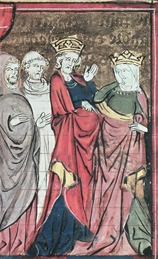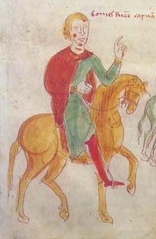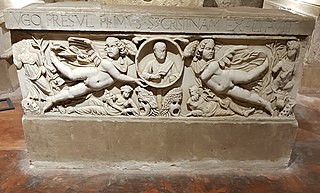
The Kingdom of Sicily was a state that existed in Sicily and the south of the Italian Peninsula plus, for a time, in Northern Africa from its founding by Roger II of Sicily in 1130 until 1816. It was a successor state of the County of Sicily, which had been founded in 1071 during the Norman conquest of the southern peninsula. The island was divided into three regions: Val di Mazara, Val Demone and Val di Noto.

Adelaide del Vasto was countess of Sicily as the third spouse of Roger I of Sicily, and Queen consort of Jerusalem by marriage to Baldwin I of Jerusalem. She served as regent of Sicily during the minority of her son Roger II of Sicily from 1101 until 1112.

Roger Borsa was the Norman Duke of Apulia and Calabria and effective ruler of southern Italy from 1085 until his death.

The Duchy of Amalfi or the Republic of Amalfi was a de facto independent state centered on the Southern Italian city of Amalfi during the 10th and 11th centuries. The city and its territory were originally part of the larger ducatus Neapolitanus, governed by a patrician, but it extracted itself from Byzantine vassalage and first elected a duke in 958.

Alfonso, also called Anfuso or Anfusus (c. 1120 – 10 October 1144), was the Prince of Capua from 1135 and Duke of Naples from 1139. He was an Italian-born Norman of the noble Hauteville family. After 1130, when his father Roger became King of Sicily, he was the third in line to the throne; second in line after the death of an older brother in 1138. He was the first Hauteville prince of Capua after his father conquered the principality from the rival Norman Drengot family. He was also the first Norman duke of Naples after the duchy fell vacant on the death of the last Greek duke. He also expanded his family's power northwards, claiming lands also claimed by the Papacy, although he was technically a vassal of the Pope for his principality of Capua.
Ranulf II was the count of Alife and Caiazzo, and duke of Apulia. He was a member of the Italo-Norman Drengot family which dominated the Principality of Capua for most of the century between 1050 and 1150. Ranulf's wife, Matilda, was the sister of King Roger II of Sicily.
Henry Aristippus of Calabria, sometimes known as Enericus or Henricus Aristippus, was a religious scholar and the archdeacon of Catania and later chief familiaris of the triumvirate of familiares who replaced the admiral Maio of Bari as chief functionaries of the Kingdom of Sicily in 1161.

Richard, count of Acerra was an Italo-Norman nobleman, grandson of Robert of Medania, a Frenchman of Anjou. Brother of Sibylla, queen of Tancred of Sicily, Richard was the chief peninsular supporter of his brother-in-law during his claim for the throne in 1189.

Hugh was the Archbishop of Capua in the late 1140s and Archbishop of Palermo from 1150 until his death, probably in 1165–66.

Dipold, known in German as Diepoldvon Schweinspünt, was a German ministerialis who was raised to the Duchy of Spoleto in 1209. Of Bavarian origin, he was a reputed younger son of Berthold II of Vohburg and Adelaide of Ballenstedt. He was originally a vassal of the count of Lechsgemünd. His career in the Mezzogiorno was marked by continual raids and sieges, battles, and sacks recounted in exhaustive detail by Richard of San Germano, a monk of the abbey whose lands were especially hard hit.
Guarin was the chaplain and chancellor of Roger II of Sicily from about 1130 to his death, during the first decade of the Norman kingdom of Sicily. According to Alexander of Telese, the contemporary chronicler, he was "erudite ... and most prudent in negotiations ... a cleric well-versed in letters, skillful in matters of the world, and possessed of a tenacious and cautious mind."

The Norman conquest of southern Italy lasted from 999 to 1194, involving many battles and independent conquerors.
Jocelyn was an Italo-Norman officer serving Roger II of Sicily.

The term Norman–Arab–Byzantine culture, Norman–Sicilian culture or, less inclusively, Norman–Arab culture, refers to the interaction of the Norman, Byzantine Greek, Latin, and Arab cultures following the Norman conquest of the former Emirate of Sicily and North Africa from 1061 to around 1250. The civilization resulted from numerous exchanges in the cultural and scientific fields, based on the tolerance shown by the Normans towards the Latin- and Greek-speaking Christian populations and the former Arab Muslim settlers. As a result, Sicily under the Normans became a crossroad for the interaction between the Norman and Latin Catholic, Byzantine–Orthodox, and Arab–Islamic cultures.

The Terra di Bari, in antiquity Peucetia and in the Middle Ages Ager Barianus, is the region around Bari in Apulia. Historically it was one of the justiciarships of the Kingdom of Sicily and later Naples. It became a province in the Two Sicilies. Today it is a part of the Province of Bari in Italy. Since 2005, according to the municipal government of Bari, it refers to the metropolitan area of the city and is trademarked for touristic purposes.
Fulco of Basacers was an Italo-Norman knight and landholder with considerable possessions in the Val di Crati in Calabria. The seat of his lordship was "Brahalla", a place or castle that no longer exists.

The County of Apulia and Calabria, later the Duchy of Apulia and Calabria, was a Norman state founded by William of Hauteville in 1043, composed of the territories of Gargano, Capitanata, Apulia, Vulture, and most of Campania. It became a duchy when Robert Guiscard was raised to the rank of duke by Pope Nicholas II in 1059.
Robert of Lauro was the Count of Caserta, a powerful nobleman and administrator in the Kingdom of Sicily, "effectively the king's viceroy on the mainland" between 1171 and his death. He was a close colleague of Count Tancred of Lecce, the future king. His influence helped his cousin Roger become Archbishop of Benevento (1179–1225).
Graham Anthony Loud is a professor emeritus of medieval history at the University of Leeds. Loud is a specialist in the history of southern Italy during the Central Middle Ages, and also in German history in the Staufen period.
Events during the year 1105 in Italy.